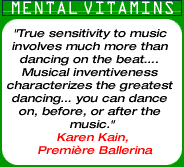Self-challenges with Style
Decide with your teacher which of these activities to complete:
Bustin' Some Psychological Moves
Dance is a form of expressing emotion. It's a form of communication. Watch a dance or music video. What emotions are the dancers trying to express?
Not only do you communicate through dance, you also need self-communication to check in on your personal progress. Keep a diary of your feelings and experiences over the course of this dance dimension. Does it give you a new perspective or help you to further understand the dance activities you've been doing? Now that you see everything you've accomplished in writing, what does it communicate to you about your abilities? What do you want to work on next? What should you give yourself a pat on the back for?
How could you manage your worst dancing nightmare come true? What if you forget the steps to a dance in the middle of a performance, or if a dance partner breaks a leg before a show? Your creativity, positive interaction with others, and sense of humour will help you find ways around any challenge - in dance and in life.

activities | health benefits | cooperation | do it daily for life
